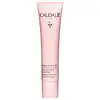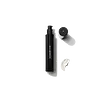Caudalie Resveratrol Lift Lightweight Firming Cashmere Moisturizer Versus Victoria Beckham Beauty Victoria Beckham By Augustinus Bader Cell Rejuvenating Priming Moisturizer
What's inside
What's inside
 Key Ingredients
Key Ingredients

 Benefits
Benefits

 Concerns
Concerns

 Ingredients Side-by-side
Ingredients Side-by-side

Water
Skin ConditioningCaprylic/Capric Triglyceride
MaskingIsostearyl Isostearate
EmollientCoco-Caprylate/Caprate
EmollientHeptyl Undecylenate
EmollientButylene Glycol
HumectantSilica
AbrasiveGlycerin
HumectantSqualane
EmollientCI 77891
Cosmetic ColorantGlyceryl Stearate Citrate
EmollientPotassium Cetyl Phosphate
EmulsifyingPalmitoyl Grapevine Shoot Extract
AntioxidantMica
Cosmetic ColorantPolyglyceryl-3 Stearate
EmulsifyingTocopheryl Acetate
AntioxidantBenzyl Alcohol
PerfumingHydrogenated Lecithin
EmulsifyingCaprylyl Glycol
EmollientXanthan Gum
EmulsifyingHydrolyzed Hyaluronic Acid
HumectantPolyacrylate Crosspolymer-6
Emulsion StabilisingAdenosine
Skin ConditioningDehydroacetic Acid
PreservativeAcetyl Dipeptide-1 Cetyl Ester
Skin ConditioningHyaluronic Acid
HumectantSodium Phytate
Khaya Senegalensis Bark Extract
Skin ProtectingMaltodextrin
AbsorbentTin Oxide
AbrasivePaeonia Lactiflora Root Extract
Skin ConditioningTocopherol
AntioxidantSodium Hydroxide
BufferingParfum
MaskingLinalool
PerfumingLimonene
PerfumingCoumarin
PerfumingWater, Caprylic/Capric Triglyceride, Isostearyl Isostearate, Coco-Caprylate/Caprate, Heptyl Undecylenate, Butylene Glycol, Silica, Glycerin, Squalane, CI 77891, Glyceryl Stearate Citrate, Potassium Cetyl Phosphate, Palmitoyl Grapevine Shoot Extract, Mica, Polyglyceryl-3 Stearate, Tocopheryl Acetate, Benzyl Alcohol, Hydrogenated Lecithin, Caprylyl Glycol, Xanthan Gum, Hydrolyzed Hyaluronic Acid, Polyacrylate Crosspolymer-6, Adenosine, Dehydroacetic Acid, Acetyl Dipeptide-1 Cetyl Ester, Hyaluronic Acid, Sodium Phytate, Khaya Senegalensis Bark Extract, Maltodextrin, Tin Oxide, Paeonia Lactiflora Root Extract, Tocopherol, Sodium Hydroxide, Parfum, Linalool, Limonene, Coumarin
Water
Skin ConditioningGlycerin
HumectantTriethylhexanoin
MaskingEthylhexyl Polyhydroxystearate
EmollientIsostearyl Isostearate
EmollientSaccharomyces/Xylinum/Black Tea Ferment
Skin Conditioning1,2-Hexanediol
Skin ConditioningOctyldodecyl Myristate
EmollientPersea Gratissima Oil
Skin ConditioningSilica
AbrasiveSodium Acrylates Copolymer
CI 77891
Cosmetic ColorantPotassium Cetyl Phosphate
EmulsifyingSodium Hyaluronate
HumectantPapain
Skin ConditioningSynthetic Fluorphlogopite
Chlorella Vulgaris Extract
Skin ConditioningLecithin
EmollientSodium Polyacrylate
AbsorbentPanthenol
Skin ConditioningCaprylic/Capric Triglyceride
MaskingCitric Acid
BufferingCetyl Palmitate
EmollientSorbitan Stearate
EmulsifyingTocopherol
AntioxidantSodium Hydroxide
BufferingCaprylyl Glycol
EmollientCarbomer
Emulsion StabilisingN-Hydroxysuccinimide
Skin ConditioningPropylene Glycol
HumectantSodium Benzoate
MaskingTin Oxide
AbrasiveAlgin
MaskingO-Cymen-5-Ol
AntimicrobialPolysorbate 80
EmulsifyingPotassium Sorbate
PreservativeHydrogenated Lecithin
EmulsifyingPalmitoyl Tetrapeptide-10
Skin ConditioningWater, Glycerin, Triethylhexanoin, Ethylhexyl Polyhydroxystearate, Isostearyl Isostearate, Saccharomyces/Xylinum/Black Tea Ferment, 1,2-Hexanediol, Octyldodecyl Myristate, Persea Gratissima Oil, Silica, Sodium Acrylates Copolymer, CI 77891, Potassium Cetyl Phosphate, Sodium Hyaluronate, Papain, Synthetic Fluorphlogopite, Chlorella Vulgaris Extract, Lecithin, Sodium Polyacrylate, Panthenol, Caprylic/Capric Triglyceride, Citric Acid, Cetyl Palmitate, Sorbitan Stearate, Tocopherol, Sodium Hydroxide, Caprylyl Glycol, Carbomer, N-Hydroxysuccinimide, Propylene Glycol, Sodium Benzoate, Tin Oxide, Algin, O-Cymen-5-Ol, Polysorbate 80, Potassium Sorbate, Hydrogenated Lecithin, Palmitoyl Tetrapeptide-10
Ingredients Explained
These ingredients are found in both products.
Ingredients higher up in an ingredient list are typically present in a larger amount.
This ingredient is an emollient, solvent, and texture enhancer. It is considered a skin-softener by helping the skin prevent moisture loss.
It helps thicken a product's formula and makes it easier to spread by dissolving clumping compounds.
Caprylic Triglyceride is made by combining glycerin with coconut oil, forming a clear liquid.
While there is an assumption Caprylic Triglyceride can clog pores due to it being derived from coconut oil, there is no research supporting this.
Learn more about Caprylic/Capric TriglycerideCaprylyl Glycol is a humectant and emollient, meaning it attracts and preserves moisture.
It is a common ingredient in many products, especially those designed to hydrate skin. The primary benefits are retaining moisture, skin softening, and promoting a healthy skin barrier.
Though Caprylyl Glycol is an alcohol derived from fatty acids, it is not the kind that can dry out skin.
This ingredient is also used as a preservative to extend the life of products. It has slight antimicrobial properties.
Learn more about Caprylyl GlycolCi 77891 is a white pigment from Titanium dioxide. It is naturally found in minerals such as rutile and ilmenite.
It's main function is to add a white color to cosmetics. It can also be mixed with other colors to create different shades.
Ci 77891 is commonly found in sunscreens due to its ability to block UV rays.
Learn more about CI 77891Glycerin is already naturally found in your skin. It helps moisturize and protect your skin.
A study from 2016 found glycerin to be more effective as a humectant than AHAs and hyaluronic acid.
As a humectant, it helps the skin stay hydrated by pulling moisture to your skin. The low molecular weight of glycerin allows it to pull moisture into the deeper layers of your skin.
Hydrated skin improves your skin barrier; Your skin barrier helps protect against irritants and bacteria.
Glycerin has also been found to have antimicrobial and antiviral properties. Due to these properties, glycerin is often used in wound and burn treatments.
In cosmetics, glycerin is usually derived from plants such as soybean or palm. However, it can also be sourced from animals, such as tallow or animal fat.
This ingredient is organic, colorless, odorless, and non-toxic.
Glycerin is the name for this ingredient in American English. British English uses Glycerol/Glycerine.
Learn more about GlycerinHydrogenated Lecithin is created from the hydrogenation of lecithin (a group of phospholipids). Hydrogenation is a chemical reaction between hydrogen and another element.
This ingredient is an emollient and emulsifier. As an emollient, it helps soften skin by trapping moisture within. As an emulsifier, it prevents oil and water ingredients from separating.
Isostearyl Isostearate comes from Isostearyl Alcohol and Isostearic Acid. It is usually derived from vegetables, such as canola oil.
Isostearyl Isostearate is an emollient and helps soften skin. It can also help thicken a product.
This ingredient isn't fungal acne safe. It can be bad for oily skin.
Learn more about Isostearyl IsostearatePotassium Cetyl Phosphate is the potassium salt of a mixture. This mixture consists of the esters from phosphoricacid and cetyl alcohol.
Potassium Cetyl Phosphate is an emulsifier and cleansing agent. Emulsifiers help stabilize a product. It does this by preventing certain ingredients from separating.
As a cleansing agent, Potassium Cetyl Phosphate helps gather oils, dirts, and pollutants from your skin. This makes it easier to rinse them away with water.
Learn more about Potassium Cetyl PhosphateSilica, also known as silicon dioxide, is a naturally occurring mineral. It is used as a fine, spherical, and porous powder in cosmetics.
Though it has exfoliant properties, the function of silica varies depending on the product.
The unique structure of silica enhances the spreadability and adds smoothness, making it a great texture enhancer.
It is also used as an active carrier, emulsifier, and mattifier due to its ability to absorb excess oil.
In some products, tiny microneedles called spicules are made from silica or hydrolyzed sponge. When you rub them in, they lightly polish away dead skin layers and enhance the penetration of active ingredients.
Learn more about SilicaSodium Hydroxide is also known as lye or caustic soda. It is used to adjust the pH of products; many ingredients require a specific pH to be effective.
In small amounts, sodium hydroxide is considered safe to use. However, large amounts may cause chemical burns due to its high alkaline.
Your skin has a natural pH and acid mantle. This acid mantle helps prevent harmful bacteria from breaking through. The acid mantle also helps keep your skin hydrated.
"Alkaline" refers to a high pH level. A low pH level would be considered acidic.
Learn more about Sodium HydroxideTin Oxide is an inorganic oxide used to add opacity and volume to a product. In nature, it is already found in mineral form. The main ore of tin is an opaque and shiny mineral called casseterite.
Tin Oxide helps remove translucency in a product, or make it more opaque. Besides adding opacity, tin oxide is used for bulking to add volume.
Tocopherol (also known as Vitamin E) is a common antioxidant used to help protect the skin from free-radicals and strengthen the skin barrier. It's also fat soluble - this means our skin is great at absorbing it.
Vitamin E also helps keep your natural skin lipids healthy. Your lipid skin barrier naturally consists of lipids, ceramides, and fatty acids. Vitamin E offers extra protection for your skin’s lipid barrier, keeping your skin healthy and nourished.
Another benefit is a bit of UV protection. Vitamin E helps reduce the damage caused by UVB rays. (It should not replace your sunscreen). Combining it with Vitamin C can decrease sunburned cells and hyperpigmentation after UV exposure.
You might have noticed Vitamin E + C often paired together. This is because it is great at stabilizing Vitamin C. Using the two together helps increase the effectiveness of both ingredients.
There are often claims that Vitamin E can reduce/prevent scarring, but these claims haven't been confirmed by scientific research.
Learn more about TocopherolWater. It's the most common cosmetic ingredient of all. You'll usually see it at the top of ingredient lists, meaning that it makes up the largest part of the product.
So why is it so popular? Water most often acts as a solvent - this means that it helps dissolve other ingredients into the formulation.
You'll also recognize water as that liquid we all need to stay alive. If you see this, drink a glass of water. Stay hydrated!
Learn more about Water